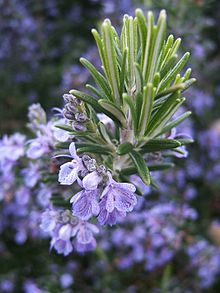 |
|
|
|
|
| Cuisines | Herbal | Spice | Curry | Yeast | Recipe | ||||||
|
Rosemary Rosmarinus officinalis, commonly known as Rosemary, is a woody, perennial herb with fragrant, evergreen, needle-like leaves and white, pink, purple or blue flowers, native to the Mediterranean region. It is a member of the mint family Lamiaceae, which includes many other herbs. The name "rosemary" derives from the Latin for "dew" (ros) and "sea" (marinus), or "dew of the sea" because in many locations it needs no water other than the humidity carried by the sea breeze to live. The plant is also sometimes called Anthos, from the ancient Greek word ἄνθος, meaning "flower". Rosemary is used as a decorative plant in gardens and has many culinary and medical uses. The plant is said to improve the memory. The leaves are used to flavor various foods, like stuffings and roast meats. Description Rosemary is an aromatic evergreen shrub that has leaves similar to hemlock needles. The leaves are used as a flavouring in foods like stuffings and roast lamb, pork, chicken and turkey. It is native to the Mediterranean and Asia, but is reasonably hardy in cool climates. It can withstand droughts, surviving a severe lack of water for lengthy periods. Forms range from upright to trailing; the upright forms can reach 1.5 m (5 ft) tall, rarely 2 m (6 ft 7 in). The leaves are evergreen, 2–4 cm (0.8–1.6 in) long and 2–5 mm broad, green above, and white below, with dense short woolly hair. The plant flowers in spring and summer in temperate climates but the plants can be in constant bloom in warm climates; flowers are white, pink, purple or deep blue. Cultivation UsageSince it is attractive and drought tolerant, Rosemary is used as an ornamental plant in gardens and for xeriscape landscaping, especially in regions of Mediterranean climate. It is considered easy to grow and pest-resistant. Rosemary can grow quite large and retain attractiveness for many years, can be pruned into formal shapes and low hedges and has been used for topiary. It is easily grown in pots. The groundcover cultivars spread widely, with a dense and durable texture. Rosemary grows on friable loam soil with good drainage in an open sunny position. It will not withstand waterlogging and some varieties are susceptible to frost. It grows best in neutral to alkaline conditions (pH 7–7.8) with average fertility. It can be propagated from an existing plant by clipping a shoot (from a soft new growth) 10–15 cm (4–6 in) long, stripping a few leaves from the bottom, and planting it directly into soil. Culinary useThe leaves, both fresh and dried, are used in traditional Mediterranean cuisine. They have a bitter, astringent taste and are highly aromatic, which complements a wide variety of foods. A tisane can be made from the leaves. When burnt, they give off a mustard-like smell and a smell similar to burning wood, which can be used to flavor foods while barbecuing. Rosemary is high in iron, calcium and vitamin B6, 317 mg, 6.65 mg and 0.336 mg per 100 g, respectively. Rosemary extract has been shown to improve the shelf life and heat stability of omega 3-rich oils, which are prone to rancidity FragranceRosemary oil is used for purposes of fragrant bodily perfumes or to emit an aroma into a room. It is also burnt as incense, and used in shampoos and cleaning products. Traditional medicineHungary water was first prepared for the Queen of Hungary Elisabeth of Poland to " ... renovate vitality of paralyzed limbs ... " and to treat gout. It was used externally and prepared by mixing fresh rosemary tops into spirits of wine. Don Quixote (Part One, Chapter XVII) mixes it in his recipe of the miraculous balm of Fierabras. Rosemary has a very old reputation for improving memory and has been used as a symbol for remembrance during weddings, war commemorations and funerals in Europe and Australia. Mourners would throw it into graves as a symbol of remembrance for the dead. In Shakespeare's Hamlet, Ophelia says, "There's rosemary, that's for remembrance." (Hamlet, iv. 5.) A modern study lends some credence to this reputation. When the smell of rosemary was pumped into cubicles where people were working, they showed improved memory, though with slower recall. Rosemary contains a number of potentially biologically active compounds, including antioxidants carnosic acid and rosmarinic acid. Other bioactive compounds include camphor (up to 20% in dry rosemary leaves), caffeic acid, ursolic acid, betulinic acid, rosmaridiphenol and rosmanol. Rosemary antioxidants levels are closely related to soil moisture content. Health precautions and toxicologyRosemary in culinary or therapeutic doses is generally safe, but can cause allergic skin reactions when used in topical preparations. According to recent European research, rosemary interferes with the absorption of iron and should not be consumed by those with iron deficiency anemia. A toxicity study of the plant on rats has shown hepatoprotective and antimutagenic activities; however, precaution is necessary for those displaying allergic reaction or are prone to epileptic seizures. Rosemary essential oil may have epileptogenic properties, as a handful of case reports over the past century have linked its use with seizures in otherwise healthy adults or children. Consumption of large quantities of rosemary should be avoided, especially during pregnancy or breastfeeding. |











